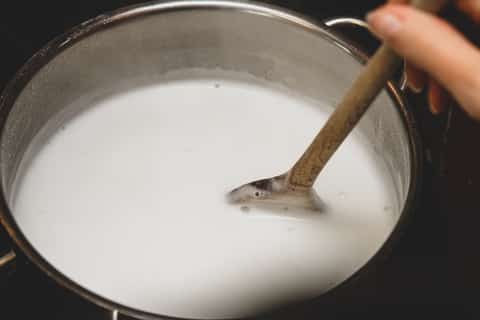
It can be frustrating to take a container of yogurt out of the fridge only to find that it isn’t smooth and silky but grainy. You may wonder if it is still safe to eat and what has caused the small lumps.
We’ve examined the causes here and will advise you on what to do with your grainy yogurt so read on to find the answers.
Graininess Can Be a Manufacturing Problem
The yogurt may not have become grainy in your fridge at home but may have been like that from the time of manufacture. Two manufacturing problems can cause graininess – inefficient smoothing and sanitizer left in the vat.
- In the factory, cultured yogurt gets fed through a smoothing device to give it a silky texture. An issue at this point in the process such as too big mesh size can result in a grainy product.
- Vats are cleaned and sterilized between batches. The sanitizer is often acid-based and if any of this is left in the vat and comes into contact with the yogurt, it will cause it to coagulate and become grainy.
If your yogurt is homemade, the graininess may be caused by your starter culture.
- Using a starter with additives may result in an unpleasant texture.
- Using too much starter can also cause your batch to become grainy.
Homemade yogurt can also become grainy if the milk was at too low a temperature when you added the starter culture. Conversely, it can also indicate that the milk was heated too fast.
Remember, heat it “low and slow”. It’s helpful to use a food thermometer to get this step right.
Is Grainy Yogurt Okay To Eat?
Now that we’ve looked at what causes yogurt to be grainy, you can probably see already that none of these reasons is going to make you sick.
Provided that your yogurt hasn’t passed the expiration date and doesn’t have any other signs of being off, you can go ahead and eat it.
If the texture bothers you, try using an immersion blender to smooth it out a little. Alternatively, use it in smoothies or in baking where the texture will not be noticeable.
How to Tell if Yogurt is Off
- Excess liquid: It’s normal for yogurt to have a little liquid on top but yogurt that’s gone bad will have a lot of liquid – either cloudy or clear – at the top.
- Textural changes: Besides graininess, spoiled yogurt may be abnormally thick or curdled.
- Use your sense of smell: If it smells funny, toss it. Bad yogurt will often have a sour or unpleasant smell (and taste).
- Mold: Of course, mold on any food is an indicator that it should be tossed immediately. Fruit yogurt is particularly prone to going moldy.
The Bottom Line
Most of the time, grainy yogurt is safe to eat. Provided it is within its expiry date, smells and looks okay, and doesn’t taste strange, it is fit for consumption.
Greek yogurt in particular seems to be prone to going grainy or lumpy. If you want a nice smooth texture, simply beat your yogurt hard with an immersion blender or electric beater.
We’d love to hear your experiences with this issue so do talk to us in the comment section below!


My first batch of German Quark was gritty. It6 should be smooth like yogurt.
Whole pasturized milk, mesophillic starter, rennet. 77 F fermentation for 24 hours, cheesecloth for 4 hours. I did not add calcium.
Should I reduce the fermentation to 12 hours? Higher, or lower temperature